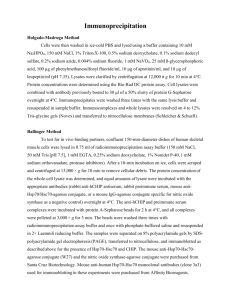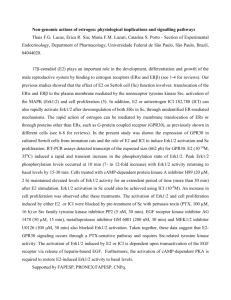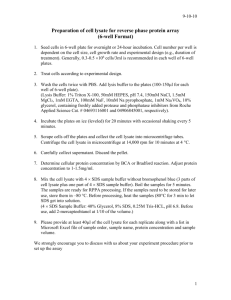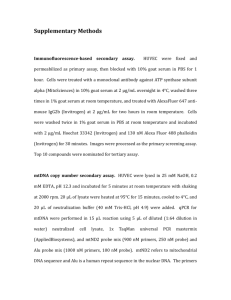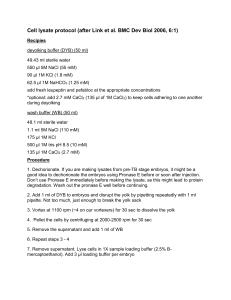(Omnia Bead IP Kinase Assay for ERK1-2).
advertisement
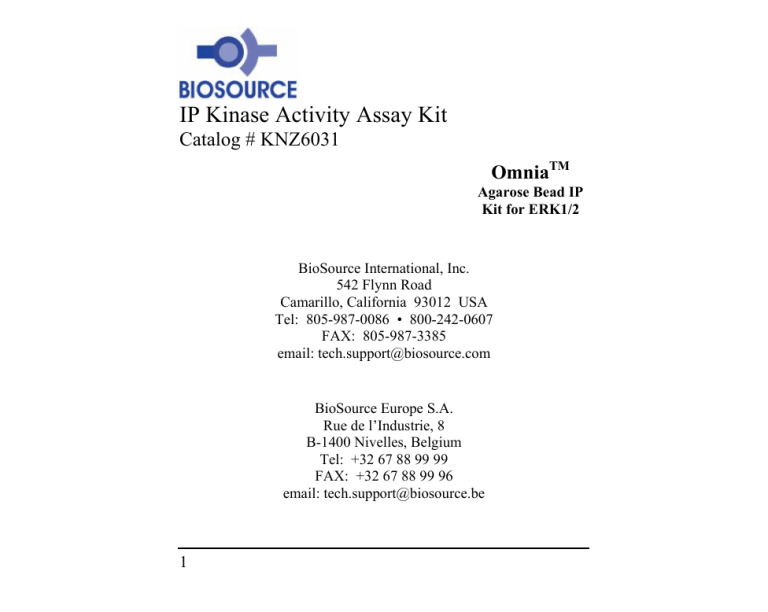
IP Kinase Activity Assay Kit Catalog # KNZ6031 OmniaTM Agarose Bead IP Kit for ERK1/2 BioSource International, Inc. 542 Flynn Road Camarillo, California 93012 USA Tel: 805-987-0086 • 800-242-0607 FAX: 805-987-3385 email: tech.support@biosource.com BioSource Europe S.A. Rue de l’Industrie, 8 B-1400 Nivelles, Belgium Tel: +32 67 88 99 99 FAX: +32 67 88 99 96 email: tech.support@biosource.be 1 2 TABLE OF CONTENTS Introduction ................................................................................. Principle of the Method................................................................. Reagents Provided ........................................................................ Safety Precautions ....................................................................... Supplies Required But Not Provided ............................................. Procedural Notes ......................................................................... Protocol and Recommended Assay Procedures........................... A. Cell Lysis Buffer Preparation ........................................ B. Extraction of Proteins from Cells................................... C. Assay Reagent Preparation ............................................ D. Assay Procedure ............................................................ OmniaTM Agarose Bead IP Kinase Assay Kit for ERK1/2 Sample Data ................................................................................ References ................................................................................... Patents, Trademarks, Limitations of Use..................................... 3 Rev. A1 12/14/06 PR377 4 5 8 9 9 11 12 12 12 14 15 17 20 20 INTRODUCTION The mitogen-activated protein kinase (MAPK) signaling pathways serve as pivotal transducers of diverse biologic functions including cell growth, differentiation, proliferation, and apoptosis1. There are at least three distinct MAPK signaling modules which mediate extracellular signals into the nucleus to turn on the responsive genes in mammalian cells, including extracellular mitogen-regulated kinase (ERK), c-Jun NH2-terminal kinase (JNK, also called stress-activated protein kinase, SAPK), and p38 kinase. The ERK signaling transduction pathway plays an essential role in regulating many cellular processes including cell differentiation and cell growth2. ERK has two closely related isoforms of 44 kDa (ERK1) and 42 kDa (ERK2), respectively. These kinases belong to a family of serine/ threonine kinases that are activated upon treatment of cells with a large variety of stimuli including mitogens, hormones, growth factors, cytokines, and bioactive peptides3. Cell stimulation induces the activation of a signaling cascade, the downstream effects of which have been linked to the regulation of cell growth and differentiation as well as the cytoskeleton4. ERK1 and ERK2 are fully activated by phosphorylation within a Thr-Glu-Tyr motif of the activation loop on both a threonine and a tyrosine residue by MEKs (MAPK/ERK kinases), thereby greatly elevating the activity of the ERK1/2 enzymes5. Activated ERK phosphorylates numerous substrates in all cellular compartments, including various membrane proteins, nuclear substrates, and cytoskeletal proteins6. This kit has been configured for research use only and is not to be used in diagnostic procedures. 4 READ ENTIRE PROTOCOL BEFORE USE PRINCIPLE OF THE METHOD The OmniaTM Agarose Bead IP Kinase Assay Kit for ERK1/2 is designed to measure the kinase activity of ERK1/2 from cell lysates. This kit uses an ERK1/2 specific monoclonal antibody to capture the target from the complex mixture of proteins in a crude cell lysate. The phosphotransferase (kinase) activity of the captured ERK1/2 is measured using a novel peptide substrate that contains the chelationenhanced fluorophore, 8-hydroxy-5-(N, N-dimethylsulfonamido)-2methylquinoline (Sox7) in a real-time kinetic measurement mode. Sox is an unnatural amino acid that can be prepared as an Fmoc protected derivative and has been incorporated into the substrate peptide using standard solid-phase peptide chemistry8. Upon phosphorylation of the peptide by ERK1/2, Mg++ is chelated to form a bridge between the Sox moiety and the phosphate group that is added by ERK1/2 to the serine residue within the peptide, resulting in an instantaneous increase in fluorescence when the kinase reaction mixture is excited at 360 nm and the emission is measured at 485 nm7. 5 A. B. C. 12000 Relative Fluorescence Units Relative Fluorescence Units 12000 10000 8000 6000 4000 2000 0 290 310 330 350 370 Wavelength, nm 390 410 10000 8000 6000 4000 2000 0 410 460 510 560 610 Wavelength, nm 6 Figure 1. A. Schematic view of Mg++ chelation by Sox and the phosphate group on the modified serine, threonine or tyrosine residue in the resulting phosphopeptide. B. Fluorescence excitation spectra of Sox peptide substrate (lower curve) and Sox phosphopeptide product (upper curve) in the presence of 15 mM MgCl2, as measured using an emission wavelength of 485 nm. C. Fluorescence emission spectra of Sox peptide substrate (lower curve) and Sox phosphopeptide product (upper curve) in the presence of 15 mM MgCl2, showing the characteristic increase in fluorescence upon phosphorylation, as measured using a constant excitation wavelength of 360 nm (for Graphs B and C, data for the OmniaTM S/T Peptide 1 are shown as an example; fluorescence increases with only OmniaTM substrates may vary). The non-phosphorylated version of the Sox-modified peptide substrate has a very low affinity for Mg++ (KD = 100 - 300 mM). The affinity for Mg++ increases dramatically upon phosphorylation (KD = 4 - 20 mM). Therefore, upon phosphorylation, most of the phosphopeptide exists in the Mg++-chelated, fluorescent state in the presence of 15 mM MgCl2. 7 REAGENTS PROVIDED Note: Store ERK1/2 Specific Monoclonal Antibody, ATP, DTT, OmniaTM S/T Peptide 17 Solution, OmniaTM S/T Phosphopeptide 17 Solution and OmniaTM Cell Lysis Buffer at -20°C, Protein A & G Agarose Beads at 2-8°C, Wash Buffer at room temperature. We recommend that the vials provided be briefly centrifuged prior to opening to bring the contents to the bottom. The OmniaTM Agarose Bead IP Kinase Assay Kit for ERK1/2 is designed to allow 40 assays (in 100 µL assay volume) to be performed in a 96-well plate. Description Formula Amount OmniaTM Cell Lysis Buffer (1x) Proprietary formulation developed to 30 mL provide optimum enzyme activity Wash Buffer Concentrate (10x) Proprietary formulation developed to 15 mL provide optimum enzyme activity OmniaTM Kinase Reaction Buffer Concentrate (10x) Proprietary formulation developed to 10 mL provide optimum enzyme activity ERK1/2 Specific Monoclonal Antibody Solution Protein A & G Agarose Beads 100 µg/mL in Antibody Dilution Buffer Suspension containing 50% beads slurry in PBS 500 µL OmniaTM S/T Peptide 17 Solution (50x) OmniaTM S/T Phosphopeptide 17 Solution (50x) Sox modified peptide substrate for ERK1/2, 1 mM solution in water Sox modified ERK1/2 phosphopeptide, 1 mM solution in water (positive control) 100 mM ATP solution in water 100 mM DTT solution in water 200 µL ATP Solution (100x) DTT Solution (500x) 800 µL 20 µL 100 µL 200 µL 8 SAFETY PRECAUTIONS This kit contains small quantities of sodium azide. Sodium azide reacts with lead and copper plumbing to form explosive metal azides. Upon disposal, flush drains with a large volume of water to prevent azide accumulation. Avoid ingestion and contact with eyes, skin and mucous membranes. In case of contact, rinse affected area with plenty of water. Observe all federal, state and local regulations for disposal. All biological materials should be handled as potentially hazardous. Follow universal precautions as established by the Centers for Disease Control and Prevention and by the Occupational Safety and Health Administration when handling and disposing of potentially hazardous materials. SUPPLIES REQUIRED BUT NOT PROVIDED 1. 2. 3. 4. 9 Fluorescence microplate reader capable of excitation wavelength at 360 nm, emission wavelength of 485 nm, and measurements in a kinetic manner (e.g., ability to take readings every 30 seconds over a 5 hour time period). This kit was developed using a SpectraMax M5® microplate reader from Molecular Devices, although other comparable instruments are acceptable. Microtiter plate for reading fluorescent signals. We recommend NBSTM 96-well Microplate (Cat. # 3992) from Corning Inc., which is a non-protein binding, white solid plastic, half well flat bottom plate. Calibrated adjustable precision pipettes with disposable plastic tips. A manifold multi-channel pipette is desirable for processing a large number of assays. Ultrapure (18MΩ) deionized H2O. 5. Plastic tubes with low protein binding for diluting and aliquoting assay components. 6. Protease and phosphatase inhibitors. We recommend Sigma Protease Inhibitor Cocktail (Cat. # P-8340) and Sigma Phosphatase Inhibitor Cocktail 2 (Cat. # P-2850, P-5726). 7. ERK1 enzyme (available from Invitrogen, Cat. # PV3311) can be used for positive experimental controls and to compare the ERK1/2 activity from cell lysates. 8. Rocking platform, shaker or rotator with a rate of 5 to 100 oscillations per minute. 9. Ultrasonic homogenizer or a 19 gauge needle and 5 mL syringe for breaking up the cells. 10. Microcentrifuge with a spin speed up to 14,000 rpm (18,000 x g). 11. Quantitative protein assay kits. We recommend the Quant-iTTM Assay Kit from Invitrogen (Cat. # Q33210). 10 PROCEDURAL NOTES 1. 2. 3. 4. 5. 6. 7. 8. 9. 11 When not in use, certain kit components need to be stored at -20°C. Please follow the recommendations for storage condition as required. All frozen reagents should be thawed on ice before use. Samples should be frozen if not analyzed shortly after collection. Avoid multiple freeze-thaw cycles of frozen samples. Thaw completely and mix well prior to analysis. If particulate matter is present, centrifuge or filter prior to analysis. All standards, controls, and samples should be run in duplicate. When pipetting reagents, maintain a consistent order of addition from well-to-well. This ensures equal incubation times for all wells. Cover or cap all reagents when not in use. Do not mix or interchange different reagent lots from various kit lots. Do not use reagents after the kit expiration date. The starting time for reading the fluorescence signal in a plate reader can be varied from 0 to 1 hour, depending on the quantity of ERK1/2 present in the cell lysate used in the study. PROTOCOL AND RECOMMENDED ASSAY PROCEDURES A. Procedure for Cell Lysis Buffer Preparation The OmniaTM Cell Lysis Buffer provided in this kit (also available separately, Cat. # CE001A) needs to be supplemented with phosphatase inhibitors (such as Phosphatase Inhibitor Cocktail, Sigma Cat. # P-2850, P-5726) and protease inhibitors (such as PMSF or AEBSF, 1 mM; Protease Inhibitor Cocktail, Sigma Cat. # P-8340) according to manufacturer’s recommendations. This buffer is stable for 2-3 weeks at 4°C or for up to 18 months at -20°C (without protease or phosphatase inhibitors added). When stored frozen, the OmniaTM Cell Lysis Buffer should be thawed on ice. Important: Add the protease inhibitors just before using. The stability of protease inhibitor supplemented OmniaTM Cell Lysis Buffer is 24 hours at 4oC. PMSF is very unstable and must be re-added just prior to use, even if added previously. B. Procedure for Extraction of Proteins from Cells When using the OmniaTM Agarose Bead IP Kinase Assay Kit for ERK1/2 to determine ERK1/2 activity in cell lysates, we recommend the following procedure for sample preparation. This protocol has been successfully applied to several cell lines of human and mouse origin. Researchers should optimize the cell extraction procedures for their own applications. 1. 2. Thaw OmniaTM Cell Lysis Buffer on ice. Set up and stimulate cells as desired. 12 3. Collect cells in cold PBS by centrifugation (for non-adherent cells) or scraping from culture plates (for adherent cells). 4. Centrifuge the cells at 1,500 rpm for 5 minutes at 4°C. 5. Aspirate the PBS. 6. Resuspend the cell pellet in 1x OmniaTM Cell Lysis Buffer and transfer the lysate to a 1.5 mL microcentrifuge tube. The volume of OmniaTM Cell Lysis Buffer depends on the cell number and expression level of ERK1/2. The optimal protein concentration of lysate should be in the range of 5 to 20 mg/mL or approximately 20 – 80 x 106 cells/mL. Add an appropriate amount of protease and phosphatase inhibitors (typically provided as a 100x stock solution) before using. Under these conditions, using 10 µL (50-200 µg) of the clarified cell extract should be sufficient for measurement of ERK1/2 activity. 7. Lyse the cells at 4°C for 30 minutes on a rotator. Whole cell extract then can be briefly sonicated or put through a syringe and needle if desired. 8. Centrifuge at 13,000 rpm for 30 minutes at 4°C. 9. Transfer the clarified cell extracts to clean microcentrifuge tubes. Determine the total protein concentration using an accepted procedure, such as the Quant-iTTM Assay Kit from Invitrogen (Cat. # Q33210). 10. The clarified cell extract should be stored at -80°C until ready for analysis. Avoid repeated freeze-thaw cycles. In preparation for performing the assay, allow the samples to thaw on ice. Mix well prior to analysis. 13 C. Procedure for Assay Reagent Preparation Prior to setting up the individual reactions, the following solutions must be prepared: 1. 2. 3. 4. 5. Wash Buffer (prepare 1x stock): Dilute an appropriate amount of the 10x Wash Buffer Concentrate 10-fold with ultrapure water (e.g., 5 mL of 10x Wash Buffer + 45 mL of ultrapure water). OmniaTM Kinase Reaction Buffer (prepare 1x stock): Dilute an appropriate amount of the 10x OmniaTM Kinase Reaction Buffer 10-fold with ultrapure water and add DTT (provided) to a final concentration of 0.2 mM (e.g., 500 µL of 10x OmniaTM Kinase Reaction Buffer + 10 µL of 100 mM DTT solution + 4,490 µL ultrapure water). OmniaTM S/T Peptide 17 Solution (prepare 100 µM stock): Dilute an appropriate amount of the provided peptide solution (1 mM) 10-fold with 1x OmniaTM Kinase Reaction Buffer (e.g., 10 µL of 1 mM peptide + 90 µL of 1x OmniaTM Kinase Reaction Buffer). ATP Solution (prepare 5 mM stock): Dilute an appropriate amount of 100 mM ATP solution 20-fold with 1x OmniaTM Kinase Reaction Buffer (e.g., 10 µL of 100 mM ATP + 190 µL of 1x OmniaTM Kinase Reaction Buffer). Cell lysates: Dilute the lysate to 0.5 to 1 mg/mL total protein with OmniaTM Cell Lysis Buffer. The amount of cell lysate protein used in the assay varies depending on the quantity and activity of ERK1/2 in the individual cell line. 14 6. ERK1 kinase: Recombinant ERK1 enzyme can be used as a positive control to quantify the activity of ERK1/2 in the cell lysates. We recommend using the product from Invitrogen (Cat. # PV3311). Dilute the ERK1 kinase to 4 ng/µL with 1x OmniaTM Kinase Reaction Buffer and store on ice until use. We recommend using 20 mU of ERK1 prepared in 10 µL of OmniaTM Kinase Reaction Buffer for each reaction. D. Assay Procedure Be sure to read the Procedural Notes section before carrying out the assay. Thaw frozen reagents on ice. Allow all reagents to reach room temperature before use. Gently mix all liquid reagents prior to use. 1. 2. 3. 4. 5. 6. 15 Add 10 µL of anti-ERK1/2 antibody solution to each tube containing 50 - 400 µg of total cell lysate protein prepared in 500 µL OmniaTM Cell Lysis Buffer and incubate overnight at 4ºC on a rocking platform. Add 20 µL Protein A & G Agarose bead suspension (50% slurry in PBS) to each of the tubes and incubate for a minimum of 2 hours at 4ºC on a rocking platform. Collect the beads by centrifugation at 10,000 rpm (12,000 x g) for 10 seconds in a microcentrifuge. Remove supernatant carefully by decanting or aspiration; add 1 mL of cold Wash Buffer to resuspend the beads. Repeat Steps 3 and 4 one more time for a total of 2 times. Remove the last trace of the Wash Buffer from the tubes using a pipette tip. Wash the beads again with 1 mL of 1x OmniaTM Kinase Reaction Buffer. 8. Collect beads by centrifugation at 10,000 rpm (12,000 x g) for 10 seconds in a microcentrifuge. Remove the supernatant from the tubes using a pipette tip. 9. Resuspend the beads with 50 µL of 1x OmniaTM Kinase Reaction Buffer and transfer the bead suspension to a well of an opaque 96-well plate (such as Corning® Nonbinding Surface Microplates, Cat. # 3992). 10. To each of the sample wells, add 20 µL of 100 µM OmniaTM S/T Peptide 17 Solution and 20 µL of 5 mM ATP, each prepared in 1x OmniaTM Kinase Reaction Buffer. The final concentration of OmniaTM S/T Peptide 17 is 20 µM, and the final concentration of ATP is 1 mM. The final reaction volume is 100 µL. 11. Transfer the plate to a fluorescence plate reader (such as SpectraMax M5® by Molecular Devices, or a comparable instrument). Read the fluorescence values of each well every 30 seconds at an excitation wavelength of 360 nm and an emission wavelength of 485 nm for up to 5 hours at 30ºC in a kinetic mode. 7. 16 OMNIATM AGAROSE BEAD IP KINASE ASSAY KIT FOR ERK1/2 SAMPLE DATA Note: All fluorescence intensity data are represented by relative fluorescence units (RFU). These values are highly instrument and assay dependent and should not be considered to represent values that are universally applicable to all users on all fluorescence detection instruments. 50000 40000 RFU PDGF-Treated NIH3T3 Cell Lysate, 400 µg Control-Treated NIH3T3 Cell Lysate, 400 µg 30000 20 µL Beads Only, No Ab. Control 20 µL Beads, 1 µg ERK1/2 Ab., No Lysate Control 20000 10000 0 60 120 180 240 300 Time (minutes) Figure 2. Measurement of ERK1/2 Activity in Crude Lysates from PDGF-Treated or Control NIH3T3 Cells. NIH3T3 cells were seeded in 100 mm dishes and grown in DMEM plus 10% fetal bovine serum until 90% confluent. The cells were then incubated overnight in serumfree medium to induce quiescence, followed by treatment with PDGF A/B (50 ng/mL, 10 min) or control media. Cell lysates were prepared and ERK1/2 activity was assayed as described in the Assay Procedure section (page 15). The PDGF-treated sample showed a reaction rate of 1.55 RFU/sec, whereas the control treated sample had a markedly reduced rate of 0.27 RFU/sec, resulting in a dramatic signal-to-noise ratio of 5.7. Other assay control groups (bead only group or bead and antibody only group) also had reaction rates less than 0.27 RFU/sec. 17 A. 60000 800 µg PDGF-Treated NIH 3T3 Cell Lysate 400 µg PDGF-Treated NIH 3T3 Cell Lysate 50000 200 µg PDGF-Treated NIH 3T3 Cell Lysate RFU 40000 100 µg PDGF-Treated NIH 3T3 Cell Lysate 800 µg Control-Treated NIH 3T3 Cell Lysate 30000 400 µg Control-Treated NIH 3T3 Cell Lysate 200 µg Control-Treated NIH 3T3 Cell Lysate 20000 100 µg Control-Treated NIH 3T3 Cell Lysate 10000 20 µL Beads no Ab. Control 20 µL Beads + 1 µg ERK1/2 Ab. No Lysate 0 0 60 120 180 240 300 Time (minutes) 1.6 B. Reaction Rate (RFU/Sec) 1.5 1.4 1.3 1.2 1.1 1 0.9 0.8 0.7 0 100 200 300 400 PDGF-Treated NIH 3T3 Cell Lysate (µg) Figure 3. Comparison of ERK1/2 Activity Using Different Amounts of Cell Lysate. A. PDGF-treated NIH3T3 lysates (800, 400, 200, 100 µg) were tested for ERK1/2 activity in comparison with the control cell lysates. B. The reaction rates of the PDGF-treated samples are directly proportional to the amounts of the protein in the samples from 50 to 400 µg, with a coefficient of correlation (R2) of 0.96. 18 50000 45000 40000 PDGF-Treated NIH3T3 Lysate - 1 PDGF-Treated NIH3T3 Lysate - 2 35000 PDGF-Treated NIH3T3 Lysate - 3 RFU 30000 PDGF-Treated NIH3T3 Lysate - 4 PDGF-Treated NIH3T3 Lysate - 5 25000 Control-Treated NIH3T3 Lysate - 1 20000 Control-Treated NIH3T3 Lysate - 2 15000 Control-Treated NIH3T3 Lysate - 3 Control-Treated NIH3T3 Lysate - 4 10000 Control-Treated NIH3T3 Lysate - 5 5000 0 0 50 100 150 200 250 300 Time (minutes) Figure 4. Reproducibility of the OmniaTM Agarose Bead IP Kinase Assay Kit for ERK1/2. Replicates (n = 5) of PDGF-treated NIH3T3 cell lysate samples (400 µg each) were tested in comparison with the control cell lysates. The PDGF-treated group showed a reaction rate of 1.57 ± 0.06 RFU/sec (% CV = 1.27%), whereas the control group had a rate of 0.33 ± 0.01 RFU/sec (% CV = 3.03%), illustrating the high precision obtained with the OmniaTM platform. 19 REFERENCES 1. 2. 3. 4. 5. 6. 7. 8. Seger, R. and Krebs, E.G. (1995) The MAPK signaling cascade. FASEB J. 9:726-735. Cavanaugh, J.E., et al. (2001) Differential regulation of mitogenactivated protein kinases ERK1/2 and ERK5 by neurotrophins, neuronal activity, and cAMP in neurons. J. Neurosci. 21:434-443. Chu, B., et al. (2005) Regulation of ERK1 gene expression by coactivator proteins. Biochem. J. 392:589-599. Kohno, M. and Pouyssegur, J. (2003) Pharmacological inhibitors of the ERK signaling pathway: application as anticancer drugs. Prog. Cell Cycle Res. 5:219-224. Canagarajah B. J., et al. (1997) Activation mechanism of the MAP kinase ERK2 by dual phosphorylation. Cell 90:859-869. Chen, Z., et al. (2001) MAP kinases. Chem. Rev. 101:2449-2476. Shults, M.D. and Imperiali, B. (2003) Versatile fluorescence probes of protein kinase activity. J. Am. Chem. Soc. 125:14248-14249. Shults, M.D., et al. (2005) A multiplexed homogeneous fluorescence-based assay for protein kinase activity in cell lysates. Nat. Methods 2:277-283. PATENTS, TRADEMARKS, LIMITATIONS OF USE These products are sold under an exclusive license from the Massachusetts Institute of Technology and are covered by patents 10/681,427 and 10/682,427. 20 NOTES 21 22 23 OmniaTM IP Kinase Assay Summary 24 Rev. A1 12/14/06 PR377
